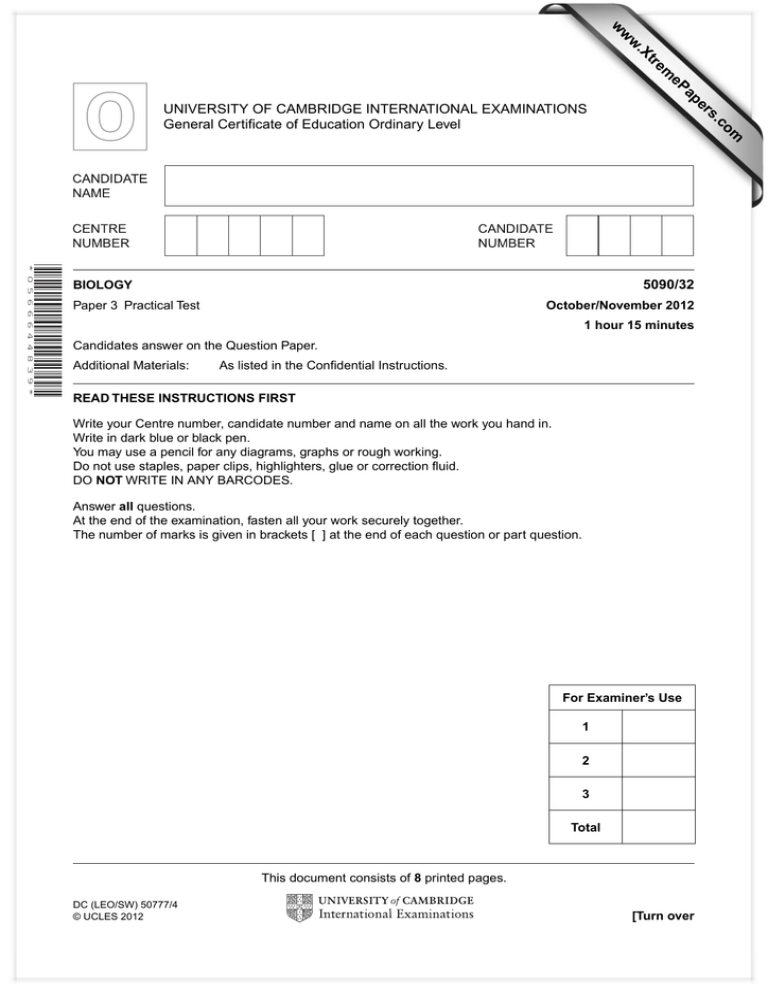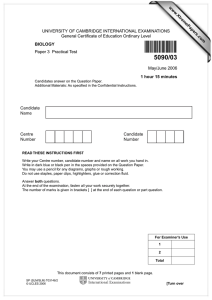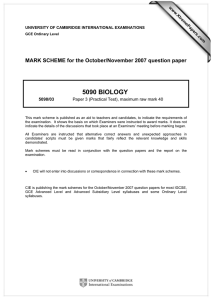www.XtremePapers.com UNIVERSITY OF CAMBRIDGE INTERNATIONAL EXAMINATIONS General Certificate of Education Ordinary Level 5090/32
advertisement

w w ap eP m e tr .X w om .c s er UNIVERSITY OF CAMBRIDGE INTERNATIONAL EXAMINATIONS General Certificate of Education Ordinary Level * 0 5 6 6 6 4 4 8 3 9 * 5090/32 BIOLOGY Paper 3 Practical Test October/November 2012 1 hour 15 minutes Candidates answer on the Question Paper. Additional Materials: As listed in the Confidential Instructions. READ THESE INSTRUCTIONS FIRST Write your Centre number, candidate number and name on all the work you hand in. Write in dark blue or black pen. You may use a pencil for any diagrams, graphs or rough working. Do not use staples, paper clips, highlighters, glue or correction fluid. DO NOT WRITE IN ANY BARCODES. Answer all questions. At the end of the examination, fasten all your work securely together. The number of marks is given in brackets [ ] at the end of each question or part question. For Examiner’s Use 1 2 3 Total This document consists of 8 printed pages. DC (LEO/SW) 50777/4 © UCLES 2012 [Turn over 2 In order to plan the best use of your time, read through all the questions on this paper carefully before starting. 1 Starch is broken down into reducing sugars by the enzyme amylase. Iodine solution is used to test for the presence of starch. When no starch is present the yellow-brown iodine solution does not change colour. If starch is present the iodine solution turns blue-black. You are required to investigate the effect of sodium chloride on the breakdown of starch by amylase. You are provided with • two test-tubes each containing 5 cm3 of 1% starch solution, labelled A and B, • two test-tubes each containing 2 cm3 of 1% amylase, labelled A2 and B2, • test-tube containing 1 cm3 of water, labelled water, • test-tube containing 1 cm3 of 0.5% sodium chloride solution labelled sodium chloride, • two dropping pipettes, • Iodine solution, • two white tiles. Proceed as follows: • Label one white tile, A and the other white tile, B. • Add 10 separate drops of iodine solution to each tile, as shown in Fig. 1.1. tile A tile B Fig. 1.1 • To test-tube A add the 1 cm3 water and the contents of A2. Record the time ......................................... • Carefully shake the mixture. • After one minute remove a drop from this mixture and add it to the first drop of iodine solution on the white tile A. • Record the colour in Table 1.1. • Continue taking one drop from the mixture every minute, recording the colour until the yellow-brown iodine solution does not change colour. © UCLES 2012 5090/32/O/N/12 For Examiner’s Use 3 • To test-tube B add the 1 cm3 of 0.5% sodium chloride solution and the contents of B2. Record the time ......................................... • Carefully shake the mixture. • Repeat the procedure of taking one drop from this mixture, adding it to the iodine solution drops on the white tile B. Record the colours in Table 1.1 until the yellow-brown colour of the iodine solution does not change colour. For Examiner’s Use (a) Time 0 minutes has been done for you. Table 1.1 time / mins test-tube A test-tube B 0 blue-black blue-black 1 2 3 4 5 6 7 8 9 10 [4] (b) (i) Using your data in Table 1.1, state how long it took for the starch to be completely broken down in test-tubes A and B. test-tube A ........................................... test-tube B .............................................. [2] (ii) Describe the effect of sodium chloride on the breakdown of starch by amylase. .................................................................................................................................. .................................................................................................................................. .............................................................................................................................. [2] © UCLES 2012 5090/32/O/N/12 [Turn over 4 (c) Explain why the following procedures were carried out (i) ‘use a white tile’ .............................................................................................................................. [1] (ii) ‘shake the mixture’ .............................................................................................................................. [1] (iii) ‘add the 1 cm3 of water to test-tube A’ .................................................................................................................................. .............................................................................................................................. [2] Some students carried out an investigation on the effect of pH on the activity of amylase. The results are shown in Table 1.2. Table 1.2 © UCLES 2012 pH time taken to break down starch / minutes 3 20 4 13 5 3 6 7 7 12 8 22 5090/32/O/N/12 For Examiner’s Use 5 (d) (i) Using the data in Table 1.2 construct a graph to show the effect of pH on the time taken for the breakdown of starch. For Examiner’s Use [4] (ii) State the optimum pH for the activity of this enzyme. .............................................................................................................................. [1] (iii) Describe and explain the effect of pH on the activity of this enzyme. .................................................................................................................................. .................................................................................................................................. .................................................................................................................................. .................................................................................................................................. .................................................................................................................................. .................................................................................................................................. .................................................................................................................................. .............................................................................................................................. [3] [Total: 20] © UCLES 2012 5090/32/O/N/12 [Turn over 6 2 You are provided with a fresh, soaked seed of broad bean, Vicia faba, labelled W1. • Carefully remove the testa (the seed coat). • Carefully separate the cotyledons (the seed leaves). For Examiner’s Use Observe the structure of the embryo on one side of the cotyledon, examining the specimen using the hand lens provided. (a) (i) Make a large, labelled drawing of the cotyledon with the embryo attached. [6] © UCLES 2012 5090/32/O/N/12 7 (ii) Measure the length of the cotyledon. For Examiner’s Use length of cotyledon ................................................. mm Measure the length of the cotyledon on your drawing. length of cotyledon on your drawing ................................................. mm Draw a line on your drawing to show where you have measured this length. Calculate the magnification of your drawing. Show your working. magnification .................................................. [3] You are provided with two different types of bean fruits labelled W2 and W3. (b) (i) Describe two observable differences, apart from size, between W2 and W3. 1 ............................................................................................................................... 2 ........................................................................................................................... [2] All bean seeds contain substantial quantities of protein. (ii) Design an investigation, but do not carry it out, to compare the protein content of the seeds from these two bean fruits W2 and W3. .................................................................................................................................. .................................................................................................................................. .................................................................................................................................. .................................................................................................................................. .................................................................................................................................. .................................................................................................................................. .............................................................................................................................. [4] [Total: 15] © UCLES 2012 5090/32/O/N/12 [Turn over 8 3 Fig. 3.1 shows the bones in the human forearm and the leg. Y For Examiner’s Use Y X X Fig. 3.1 (a) Describe how the arrangement of bones is similar in the forearm and the leg, excluding the joints. .......................................................................................................................................... .......................................................................................................................................... .......................................................................................................................................... .......................................................................................................................................... .......................................................................................................................................... ...................................................................................................................................... [3] (b) Describe the movement that can be made at X and Y. X ...................................................................................................................................... Y .................................................................................................................................. [2] [Total: 5] Permission to reproduce items where third-party owned material protected by copyright is included has been sought and cleared where possible. Every reasonable effort has been made by the publisher (UCLES) to trace copyright holders, but if any items requiring clearance have unwittingly been included, the publisher will be pleased to make amends at the earliest possible opportunity. University of Cambridge International Examinations is part of the Cambridge Assessment Group. Cambridge Assessment is the brand name of University of Cambridge Local Examinations Syndicate (UCLES), which is itself a department of the University of Cambridge. © UCLES 2012 5090/32/O/N/12





